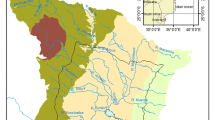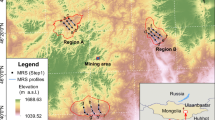Abstract
The Hunshandake Sandy Land (HSL) is a well-known water-rich sandy region in China that is home to many lakes. Most of these lakes are sustained by groundwater inflow. However, due to the limited hydrogeological survey data, the mechanism by which the lakes interact with groundwater is not well understood. Magnetic resonance sounding (MRS) is a geophysical method that has emerged in recent years that can directly detect the distribution of groundwater and determine the lithology of the aquifer medium. Compared with drilling, this method is convenient, rapid, and inexpensive. In this study, to determine how the lakes are recharged by groundwater, a field experiment using MRS was conducted on Haoletuyin Lake, which is located in the central HSL. The results showed that compared with borehole data, the MRS-derived aquifer depth has an uncertainty of 6.88%. Additionally, the lithology of the media derived from the MRS is consistent with that derived from the borehole data. This finding suggests that the MRS-derived results are highly accurate. Based on the MRS-derived results, two hydrogeological profiles were plotted, and they show that the lake in the experimental area is recharged primarily by shallow groundwater and not by deep groundwater. This study is significant because it not only reveals the mechanism by which Haoletuyin Lake is maintained, but also proves that MRS is an excellent tool for studying lake-groundwater relations in desert (sandy land) regions with limited hydrogeological survey data.









Similar content being viewed by others
References
Baroncini-Turricchia G, Francés AP, Lubczynski MW, Martínez-Fernández J, Roy J (2014) Integrating MRS data with hydrologic model-Carrizal Catchment (Spain). Near Surface Geophys 12:255–269
Behroozmand AA, Teatini P, Pedersen JB, Auken E, TosattoO CAV (2017) Anthropogenic wetlands due to over-irrigation of desert areas: a challenging hydrogeological investigation with extensive geophysical input from TEM and MRS measurements. Hydrol Earth Syst Sci 21:1527–1545
Ben-Itzhak LL, Gvirtzman H (2005) Groundwater flow along and across structural folding: an example from the Judean Desert, Israel. J Hydrol 312:51–69
Boucher M, Favreau G, Vouillamoz JM, Nazoumou Y, Legchenko A (2009) Estimating specific yield and transmissivity with magnetic resonance sounding in an unconfined sandstone aquifer (Niger). Hydrogeol J 17:1805–1815
Costabel S, Müller-Petke M (2014) Despiking of magnetic resonance signals in time and wavelet domains. Near Surface Geophys 12:185–197
Descloitres M, Chalikakis K, Legchenko A, Moussa AM, Genthon P, Favreau G, Coz ML, Boucher M, Oï M (2013) Investigation of groundwater resources in the Komadugu Yobe Valley (Lake Chad Basin, Niger) using MRS and TDEM methods. J Afr Earth Sc 87:71–85
Díaz-Curiel J, Biosca B, Doñate-Matilla G, Rueda-Quintero S (2018) Estimation of hydraulic transmissivity from MRS by varying the porosity exponent in detrital aquifers of the Iberian Peninsula. Near Surface Geophys 16:401–410
Dlugosch R, Günther T, Müller-Petke M, Yaramanci U (2013) Improved prediction of hydraulic conductivity for coarse-grained, unconsolidated material from nuclear magnetic resonance. Geophysics 78(4):55–64
Francés AP, Lubczynski MW, Roy J, Santos FAM, Ardekani MRM (2014) Hydrogeophysics and remote sensing for the design of hydrogeological conceptual models in hard rocks—Sardón catchment (Spain). J Appl Geophys 110:63–81
Gates JB, Edmunds WM, Darling WG, Ma J, Pang Z, Young AA (2008) Conceptual model of recharge to southeastern Badain Jaran Desert groundwater and lakes from environmental tracers. Appl Geochem 23:3519–3534
Ge J, Chen JS, Ge L, Wang T, Wang C, Chen Y (2016) Isotopic and hydrochemical evidence of groundwater recharge in the Hopq Desert. NW China J Radioanal Nucl Chem 310(2):761–775
Ghoubachi SY (2012) Impact of Lake Nasser on the groundwater of the Nubia sandstone aquifer system in Tushka area, South Western Desert. Egypt J King Saud Univ Sci 24:101–109
Giang NV, Nam TD, Bano M (2012) Groundwater investigation on sand dunes area in southern part of Vietnam by magnetic resonance sounding. Acta Geophys 60(1):157–172
Günther T, Müller-Petke M (2012) Hydraulic properties at the North Sea island of Borkum derived from joint inversion of magnetic resonance and electrical resistivity soundings. Hydrol Earth Syst Sci 16:3279–3291
Hou L, Wang X, Hu BX, Shang J, Wan L (2016) Experimental and numerical investigations of soil water balance at the hinterland of the Badain Jaran Desert for groundwater recharge estimation. J Hydrol 540:386–396
Jiang C, Lin J, Lin T, Duan Q, Sun S, Tian B (2011) Statistical stacking and adaptive notch filter to remove high-level electromagnetic noise from MRS measurements. Near Surface Geophys 9:459–468
Jiang C, Müller-Petke M, Lin J, Lin T, Yaramanci U (2015) Imaging shallow three dimensional water-bearing structures using magnetic resonance tomography. J Appl Geophys 116:17–27
Jiang C, Shang X, Lin T, Duan Q, Lin J (2017) Quasi-2D block inversion of large-scale surface nuclear magnetic resonance profile data using a laterally constrained model. Geophysics 82(2):JM1–JM14
Jin K, Rao W, Tan H, Song Y, Yong B, Zheng F, Chen T, Han L (2018) H-O isotopic and chemical characteristics of a precipitation-lake water-groundwater system in a desert area. J Hydrol 559:848–860
Legchenko A, Baltassat JM, Beauce A, Bernard J (2002) Nuclear magnetic resonance as a geophysical tool for hydrogeologists. J Appl Geophys 50:21–46
Legchenko A, Baltassat JM, Bobachev A, Martin C, Robain H, Vouillamoz JM (2004) Magnetic resonance sounding applied to aquifer characterization. Groundwater 42(3):363–373
Luo X, Jiao JJ, Wang X, Liu K (2016) Temporal 222Rn distributions to reveal groundwater discharge into desert lakes: Implication of water balance in the Badain Jaran Desert, China. J Hydrol 534:87–103
McCool J (2019) Carbonates as evidence for groundwater discharge to the Nile River during the Late Pleistocene and Holocene. Geomorphology 331:4–21
Müller-Petke M, Dlugosch R, Lehmann-Horn J, Ronczka M (2015) NMR average pore size estimations outside the fast diffusion regime. Geophysics 80(3):D195–D206
Perttu N, Wattanasen K, Phommasone K, Elming S (2011) Determining water quality parameters of aquifers in the Vientiane Basin, Laos, using geophysical and water chemistry data. Near Surface Geophys 9:381–395
Plata JL, Rubio FM (2008) The use of MRS in the determination of hydraulic transmissivity: the case of alluvial aquifers. J Appl Geophys 66:128–139
Ren X, Zhu B, Liu M, Zhang Y, He Z, Rioual P (2018) Mechanism of groundwater recharge in the middle-latitude desert of eastern Hunshandake, China: diffuse or focused recharge? Hydrogeol J 27:761–783
Roy J, Rouleau A, Chouteau M, Bureau M (2008) Widespread occurrence of aquifers currently undetectable with the MRS technique in the Grenville geological province, Canada. J Appl Geophys 66:82–93
Schirov M, Legchenko AV, Creer G (1991) New direct non-invasive groundwater detection technology for Australia. Explor Geophys 22:333–338
Snineh M, Laftouhi N, Mehdi K, Mandour AE, Hejjaj A, Mandi L (2018) Contribution of the MRS method to identifying fractured basement rock aquifers in an arid area: a case study near the Bleida mine site in Morocco. Environ Earth Sci 77:102
Turner JV, Townley LR (2006) Determination of groundwater flow-through regimes of shallow lakes and wetlands from numerical analysis of stable isotope and chloride tracer distribution patterns. J Hydrol 320:451–483
Vilhelmsen TN, Christensen S, Auken E (2016) On determining uncertainties of magnetic resonance sounding estimated transmissivities for groundwater modeling. Geophysics 81(4):WB63–WB73
Vouillamoz JM, Descloitres M, Toe G, Legchenko A (2005) Characterization of crystalline basement aquifers with MRS: comparison with boreholes and pumping tests data in Burkina Faso. Near Surface Geophys 3:205–213
Vouillamoz JM, Favreau G, Massuel S, Boucher M, Nazoumou Y, Legchenko A (2008) Contribution of magnetic resonance sounding to aquifer characterization and recharge estimate in semiarid Niger. J Appl Geophys 64:99–108
Vouillamoz JM, Lawson FMA, Yalo N, Descloitres M (2015) Groundwater in hard rocks of Benin: regional storage and buffer capacity in the face of change. J Hydrol 520:379–386
Vouillamoz JM, Sophoeun P, Bruyere O, Arnout L (2014) Estimating storage properties of aquifer with magnetic resonance sounding: a field verification in northern Cambodia of the gravitational water apparent cutoff time concept. Near Surface Geophys 12:211–216
Vouillamoz JM, Valois R, Lun S, Caron D, Arnout L (2016) Can groundwater secure drinking-water supply and supplementary irrigation in new settlements of North-West Cambodia? Hydrogeol J 24:195–209
Wang L, Dong Y, Xu Z, Qiao X (2017) Hydrochemical and isotopic characteristics of groundwater in the northeastern Tennger Desert, northern China. Hydrogeol J 25:2363–2375
Wang X, Zhou Y (2018) Investigating the mysteries of groundwater in the Badain Jaran Desert, China. Hydrogeol J 26:1639–1655
Wattanasen K, Elming S (2008) Direct and indirect methods for groundwater investigations: a case-study of MRS and VES in the southern part of Sweden. J Appl Geophys 66:104–117
Yang X, Ding Z, Fan X, Zhou Z, Ma N (2007) Processes and mechanisms of desertification in northern China during the last 30 years, with a special reference to the Hunshandake Sandy Land, eastern Inner Mongolia. CATENA 71:2–12
Yang X, Scuderi LA (2010) Hydrological and climatic changes in deserts of China since the late Pleistocene. Quatern Res 73:1–9
Yang X, Scuderi LA, Wang X, Scuderi LJ, Zhang D, Li H, Forman S, Xu Q, Wang R, Huang W, Yang S (2015) Groundwater sapping as the cause of irreversible desertification of Hunshandake Sandy Lands, Inner Mongolia, northern China. PNAS 112:702–706
Yaramanci U, Müller-Petke M (2009) Improvements in inversion of magnetic resonance exploration—water content, decay Time, and resistivity. J Earth Sci 20:592–605
Yu X, Zhao G, Zhao Y, Wang M, Liu D, Liu T (2019) Detecting groundwater sources for water supplies using magnetic resonance sounding in arid areas with scarce hydrogeological data: a case study on the Mongolian Plateau. Hydrogeol J 27:1739–1752
Zhu Z, Wu Z, Liu S, Di X (1980) An outline of Chinese deserts. Science press, Beijing (in Chinese)
Acknowledgements
This research was financially supported by the Basic Scientific Research Foundation Special Project of the China Institute of Water Resources and Hydropower Research (nos. MK2019J04 and MK2019J05) and the National Natural Science Foundation of China (nos. 41402224 and 51779156).
Author information
Authors and Affiliations
Corresponding authors
Additional information
Publisher's Note
Springer Nature remains neutral with regard to jurisdictional claims in published maps and institutional affiliations.
Rights and permissions
About this article
Cite this article
Yu, X., Wu, Y., Jiang, C. et al. Magnetic resonance sounding evidence shows that shallow groundwater discharge maintains the lake landscape in the Hunshandake Sandy Land, North China. Environ Earth Sci 79, 327 (2020). https://doi.org/10.1007/s12665-020-09076-2
Received:
Accepted:
Published:
DOI: https://doi.org/10.1007/s12665-020-09076-2




